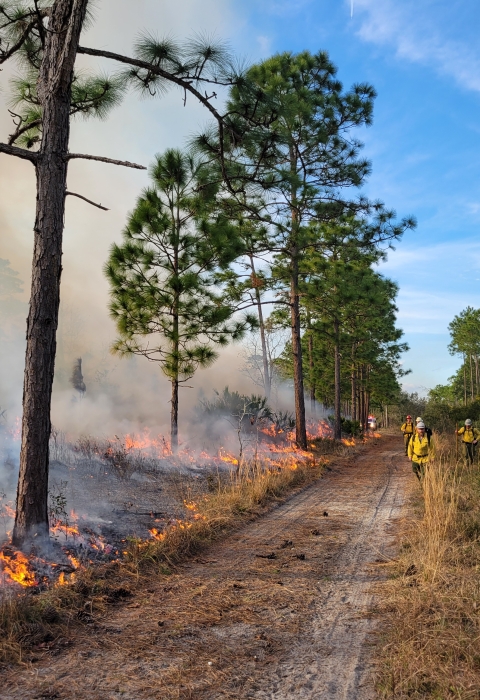Life's journey often leads us down unexpected paths. One moment, you're entrenched in a career as a biological technician, the next, you find yourself amidst the flames as a wildland fire apprentice. This unpredictability is precisely what Lindsey Green encountered as she transitioned from her previous profession to her current role at Pocosin Lakes National Wildlife Refuge in North Carolina. Join us as we look at this apprentice’s journey into the world of wildland fire, exploring the moments that have shaped her career trajectory.
Q: How long have you been in fire?
Prior to joining the Wildland Fire Apprenticeship Program with U.S. Fish and Wildlife Service, I was a biological technician for Pea Island and Alligator River National Wildlife Refuges in North Carolina. During my time there, I was also a collateral duty firefighter, mostly helping with prescribed fires. A collateral duty firefighter is someone who holds another primary role, in my case biological technician, but also fulfills duties related to firefighting as a secondary or collateral responsibility. In February of 2022, I applied for a Wildland Fire Apprenticeship position and got it! Now, I’m almost through the program and will then move into a permanent wildland fire position with the U.S. Fish and Wildlife Service.
Q: What detail assignments have you filled as part of the apprentice program?
Being a part of the Wildland Fire Apprenticeship Program has allowed me to travel all over and learn about the different types of wildland fire crews and what it takes to manage wildland fire and build relationships with other wildland fire personnel. So far, I’ve been able to experience what it’s like to be on a hand crew, an engine crew, and even completed some helicopter assignments. I’ve also traveled to Minnesota, South Dakota, and Nebraska to assist with prescribed burning assignments. Over the next few months, I will experience working in a dispatch center.
Q: Where did you grow up?
I grew up in South Florida. I went to school in Orlando and attended collage at the University of Central Florida where she studied Environmental Science/Biology. A year after I graduated, I moved up to North Carolina for the seasonal biological technician position.
Q: Recently, you joined a National Interagency Prescribed Fire Training Center
Our burn module was based in Titusville, Florida, for the first part of our assignment, where we joined an interagency burn with Florida State Parks. We completed prescribed burns at Faver-Dykes, Dunns Creek, Lake Louisa, Bulow Creek, and Kissimmee Prairie Preserve State Parks! After we completed those burns, we traveled to the Florida panhandle where we burned with the Florida Forest Service at Tate’s Hell State Forest.
Q: Can you tell me more about being a part of a burn module and what exactly it entails?
The National Interagency Prescribed Fire Training Center brings together individuals from all over the country from different fire backgrounds and experience levels to train them on specific prescribed fire skills. Essentially, any individual who wants to join has to apply for a specific training position – RXB2 (Prescribed Fire Burn Boss), FIRB (Firing Boss), ENGB (Engine Boss), FEMO (Fire Effects Monitor), FFT1 (Firefighter Type 1). Once selected, that person is placed into that role in a new environment to gain those skills. I absolutely love the National Interagency Prescribed Fire Training Center because it promotes learning, training, and understanding the objectives of each area.
Q: Can you tell me about your overall experience on the module with the training center? What did you learn?
My experience with my module was awesome. Each person brought a different perspective, and I had a great time getting to know and work with each person during my time there. It was great getting to burn in Florida and experiencing the different landscapes and objectives with each state park and forest. I was pushed out of my comfort zone multiple times, and I truly appreciate that opportunity. My group and field coordinators created a fantastic learning environment that allowed me to fully work through each situation.
Many times, when you’re on a prescribed fire, there can be an overwhelming goal to complete acres. The National Interagency Prescribed Fire Training Center helps shift that focus more on the objectives of the burn and what firing techniques are optimal for those objectives. Being a part of a module provided me the latitude to implement different techniques so I could see firsthand what worked, what didn’t work, and when to adjust tactics.






